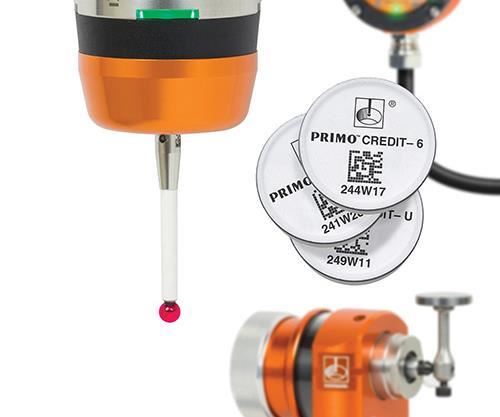“Pay As You Go” Probing
This part- and tool-setting probing system minimizes upfront costs by using a “pay as you go” model, whereby users purchase a six-month credit token that enables unlimited use of the system during that period.
On-machine probing offers a number of advantages. Probing routines using a touch-trigger probe installed in a machine’s spindle can speed setups by establishing the exact location of a workpiece fixtured on a machine so the part program can be aligned to it. This type of probing can also be applied in a more sophisticated manner for process control, using part measurement data to automatically apply cutter compensations. Similarly, a tool-setting probe installed on machine’s bed can be used to automatically measure tool length and tool diameter with the toolholder assembly installed in the machine’s spindle to further speed setup time for a new job.
Although numerous large machining operations have recognized the value of on-machine probing and integrated this technology into their processes, smaller shops have been less inclined to do so. Recent research by Renishaw, whose chairman and chief executive, Sir David McMurtry, invented the touch-trigger probe in the 1970s, shows that what has held some companies back from using probes is initial investment cost, ease of use and durability.
This spurred the company to develop an alternate concept to enable shops of all sizes to more affordably leverage on-machine probing. Renishaw’s new Primo twin-probe system uses a “pay as you go” model, combining minimal up-front costs, a comprehensive training package and immediate parts replacement to lower the overall cost of on-machine probing for all shops, the company says. Currently available in Asia, the Primo system is scheduled for U.S. availability in late 2016.
The primary components of the Primo twin-probe system are a part-setting probe with radio interface and a 3D tool-setting probe. The part-setting probe is installed in a machine’s spindle and moved under machine control during the measuring cycle. A precise trigger signal is generated when its stylus touches the workpiece. This signal is sent via radio transmission to the radio interface mounted inside the machine’s workzone that is hardwired to the machine’s CNC, which records the position of that workpiece feature. A secure frequency-hopping, spread-spectrum (FHSS) radio transmission system maintains a reliable connection between the probe and radio interface. Renishaw says benefits include reduced setup times compared to manual methods; automatic updating of work offsets; elimination of manual data input errors; and reduced fixture, scrap and rework costs.
The system’s tool-setting probe automatically measures a tool’s length when the tooltip contacts the probe axially and the tool’s diameter once either side of the tool contacts the probe. This offers benefits similar to the part-setting probe, including reduced tool-setting time compared to manual methods, automatic updating of tool offsets, detection of broken tools, eliminating manual data input errors and variation when setting tools, and reduced scrap and rework.
Primo credit tokens enable the system’s unique “pay as you go” concept. Users purchase a six-month token that enables unlimited use of the Primo system during that period. (The Primo system can only operate when there is credit available.) Once the credit expires, users can purchase an additional token to extend system use by another six months. Alternately, an upgrade token is also available at a one-time cost to provide unrestricted continuous use.
Credit information is automatically transferred from the credit token to the radio interface where it is stored. A clock in the interface starts to count down the number of days of remaining credit and runs continuously until the credit reaches zero, and users can add credit to the system at any time. A display on the interface’s front panel indicates the number of days of credit remaining, along with system status information. Registration of a valid credit token activates Primo Total Protect, which offers coverage against accidental probe damage and free replacement of any hardware element that is damaged.
The Primo system includes GoProbe software that supports programming for part setting, tool setting and calibration. Also included is a comprehensive, self-study package with a range of training tools and modules, including a pocket-sized booklet that guides users through the basic five steps of probing; a quick reference tool of the single-line probing commands; an interactive smartphone app that enables users to select a part’s features and variables to generate the single-line command; a PC-based, self-study training course featuring exercises to build expertise in programming probing cycles; and a training “workpiece” that contains many of the features common to part probing. The system is also said to be the first to enable probe-on-probe calibration, greatly reducing calibration time that might otherwise take as many as 40 minutes to complete for both the part-setting probe and tool-setting probe.
Related Content
Parts and Programs: Setup for Success
Tips for program and work setups that can simplify adjustments and troubleshooting.
Read More5 Things CNC Operators Must Know About Sizing Adjustments
For CNC operators, sizing adjustment is an essential skill. Keep these points in mind when training new CNC users.
Read MoreHow to Calibrate Gages and Certify Calibration Programs
Tips for establishing and maintaining a regular gage calibration program.
Read MoreA Case for Combining Workholding with Optical Scanning
Automotive dies and die inserts are often complex, one-off parts with little room for error. Integrity Tool's investments in modular workholding tools and 3D optical scanning have allowed the company to create niche capabilities for its CNC machined parts.
Read MoreRead Next
3 Mistakes That Cause CNC Programs to Fail
Despite enhancements to manufacturing technology, there are still issues today that can cause programs to fail. These failures can cause lost time, scrapped parts, damaged machines and even injured operators.
Read MoreThe Cut Scene: The Finer Details of Large-Format Machining
Small details and features can have an outsized impact on large parts, such as Barbco’s collapsible utility drill head.
Read More
.jpg;width=70;height=70;mode=crop)











.png;maxWidth=300;quality=90)














